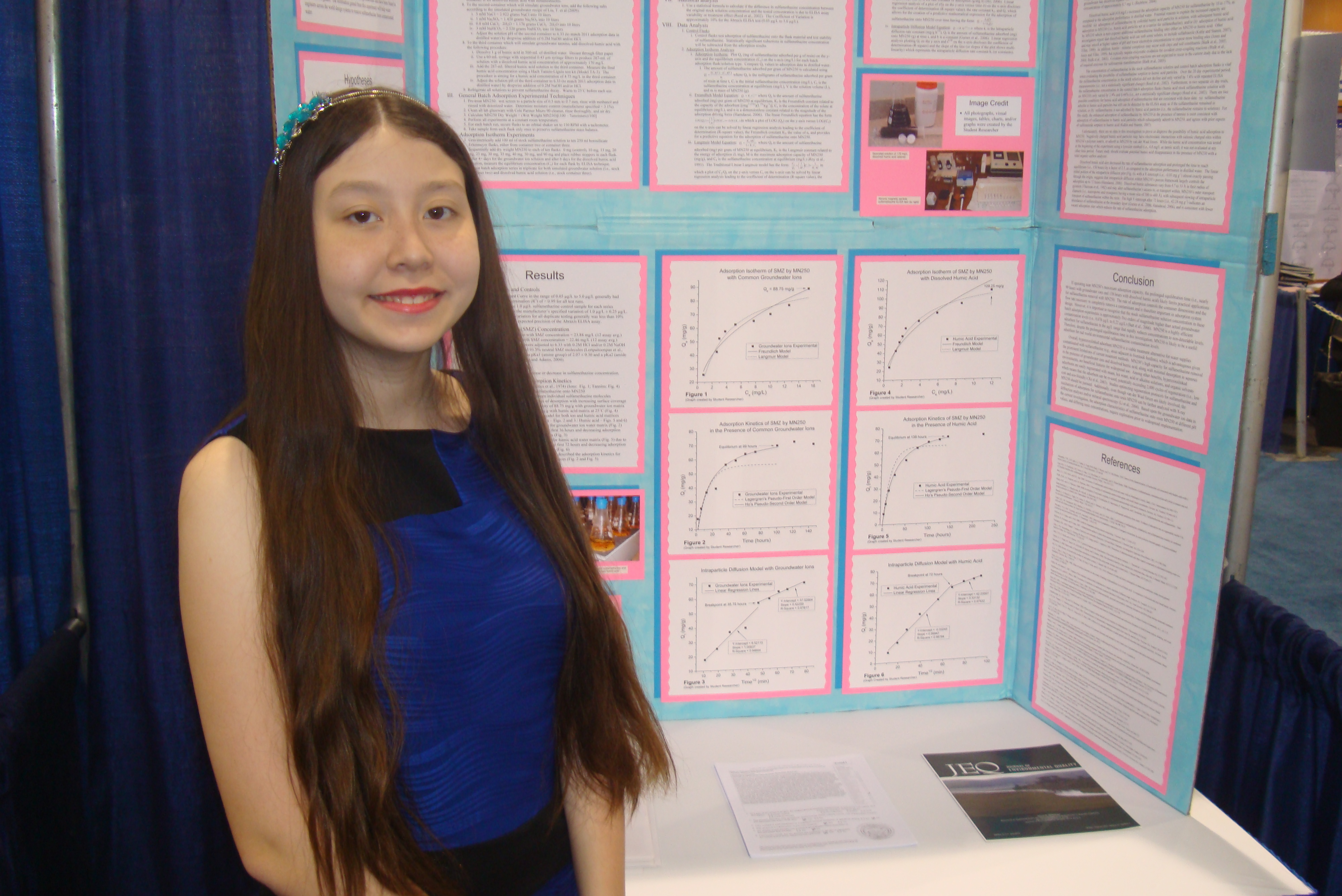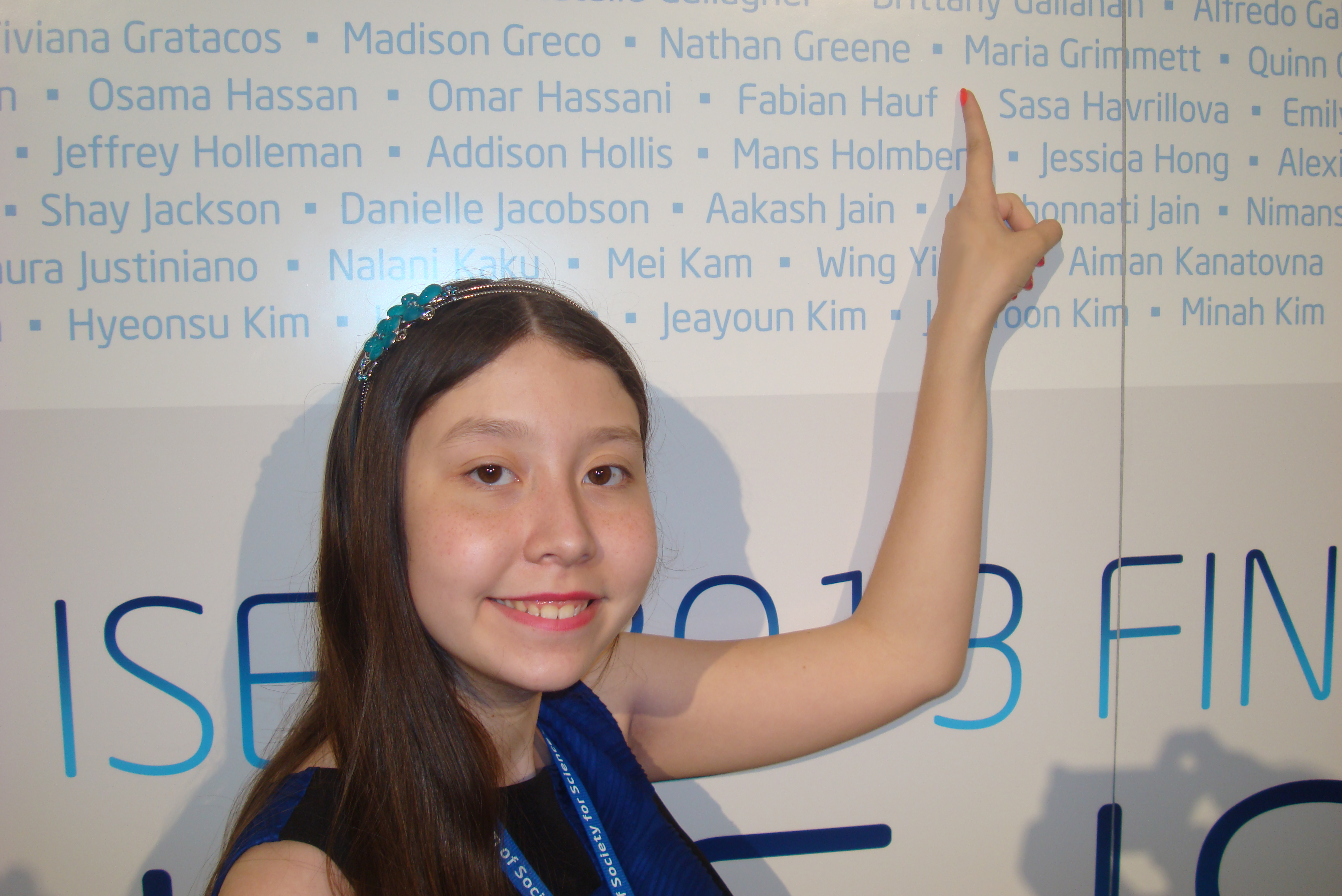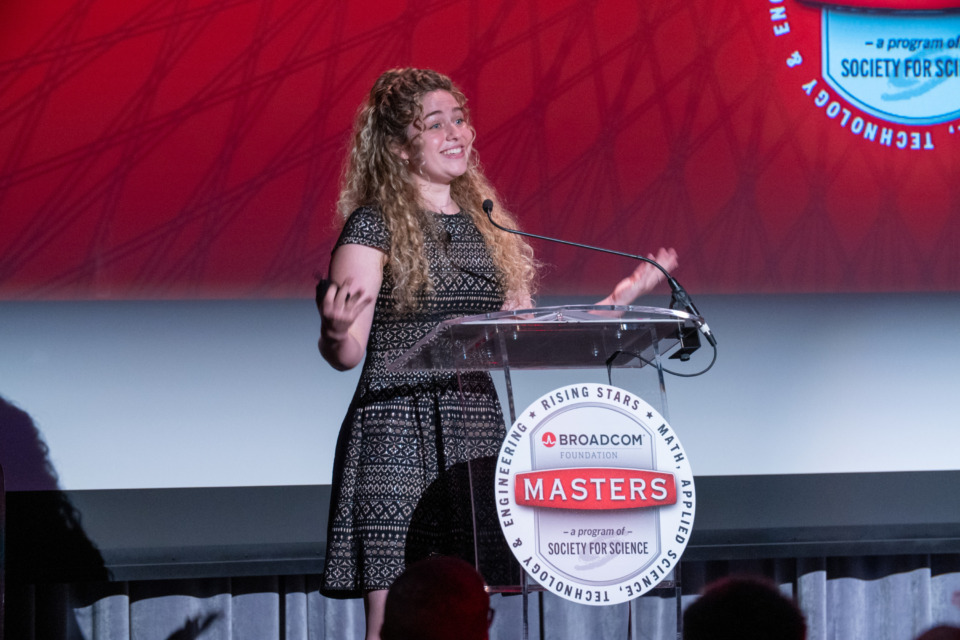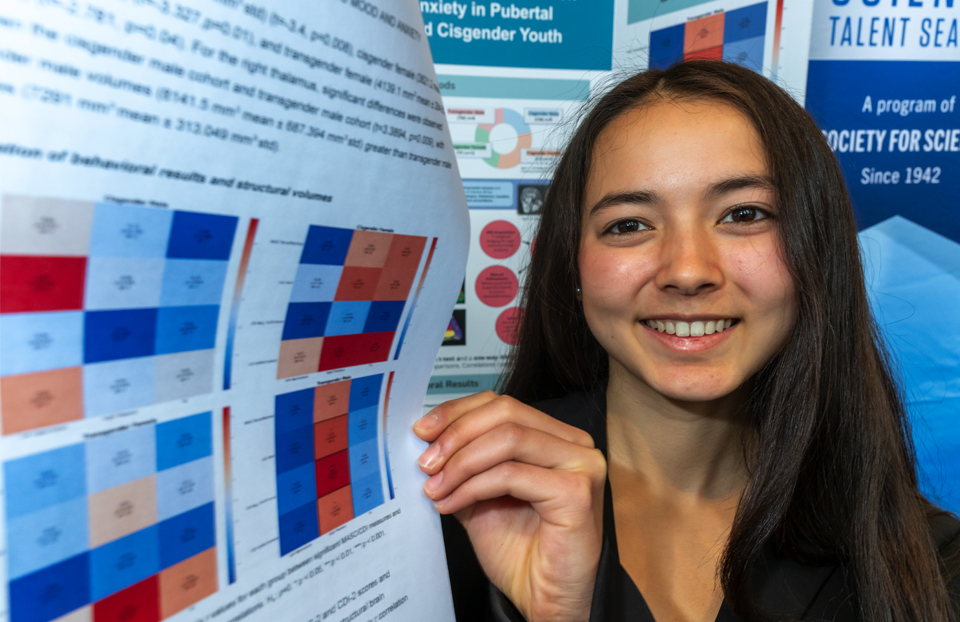Alumni, Broadcom MASTERS, ISEF
Maria Grimmett, Broadcom MASTERS and Intel ISEF Alumna, Continues Water Quality Research

Maria Elena Grimmett was a Broadcom MASTERS finalist in 2011 and 2012. In 2012, she won the first place award in Mathematics. Maria also won a third award in Environmental Science at Intel ISEF 2013. She recently published her research in the Journal of Environmental Quality. Below she talks about her experiences in both Society competitions and conducting research on water quality.
What was your experience being a Broadcom MASTERS finalist like? Most memorable moments, etc?
I was lucky enough to attend Broadcom MASTERS two years in a row, in both 2011 and 2012, and it is a phenomenal experience. I was 12 years old when I first traveled to Washington, D.C. for the Broadcom MASTERS program and I had never met a group of students such as the ones I met there. It was amazing working in teams with the other finalists to produce more than any one of us could have done alone. The end of the week was highlighted by the Lincoln Laboratories of MIT naming a minor planet after each finalist. We all laughed when we were assured by the presenter that none of our named minor planets would crash into Earth and destroy it!
Can you provide a short description of the research you presented?
My research described a novel method to remove a groundwater organic contaminant, the drug sulfamethazine, using hypercrosslinked synthetic adsorbents. In 2009, I learned that standard methods to remove organic contaminants from water had prominent limitations and I wanted to find a better way.

My seventh grade project in 2010 compared the performance of four different hypercrosslinked polystyrene adsorbents to remove sulfamethazine from contaminated water in a column flow apparatus under realistic operating conditions. I found that Purolite MN250, a hypercrosslinked synthetic adsorbent, removed 311 µg/L of sulfamethazine to non-detectable levels. I expanded this line of research in eighth grade by exploring the capacity and rate of sulfamethazine removal by hypercrosslinked adsorbent MN250 using a technique known as “batch adsorption,” which basically determined the amount and speed of sulfamethazine uptake per gram of synthetic adsorbent.
The results of my research were very favorable. I found that Purolite resin MN250 has a high capacity for sulfamethazine adsorption, is favorable for sulfamethazine removal at known environmental concentrations (i.e., the low µg/L range), and has minimal desorption in distilled water (i.e., it holds onto sulfamethazine very tightly). These features show promise for remediation of sulfamethazine contaminated water supplies. You can learn more about my research in the January 2013 issue of the Journal of Environmental Quality (Grimmett ME. 2013. Removal of Sulfamethazine by Hypercrosslinked Adsorbents in Aquatic Systems. JEQ. 42:2–9. doi:10.2134/jeq2012.0219)
How did you initially become interested in science and this topic specifically?
Ever since third grade, my favorite school activity was my yearly science fair project because my science teacher made science fun! Over many years, I really got hooked on science because I realized that the scientific method is a series of logical steps that can identify and solve difficult problems and help the world.
My current research focus actually started back in sixth grade with a simple question: “Why is my well water brown?” That year, I performed a science project on removing fulvic and humic acids, or color, from water, using three different anion exchange resins. I presented this research at the 2009 Palm Beach County Science Fair where I saw another student’s project describing pharmaceutical contamination of the Florida Everglades. I was shocked! I wanted to try and fix that problem.
After months of background research and attending a water convention where I interviewed dozens of water professionals, I ultimately decided to use hypercrosslinked adsorbents to remove the pharmaceutical sulfamethazine from contaminated water. Hypercrosslinked adsorbents are tiny plastic beads made up of polystyrene polymers that are approximately 0.5 mm in size. They have extremely high surface areas, the capacity to remove both polar and non-polar organic compounds, and can be regenerated, which makes them an eco-friendly product because they can be reused up to 2,000 times. I chose sulfamethazine as my test water contaminant because it is the most commonly used veterinary antibiotic to promote both the health and growth of livestock and is known to contaminate both ground and surface water, human food supplies, has toxicity to aquatic ecosystems, and is harmful to normal soil bacteria and enzymes.
How has doing original research and participating in events like the Broadcom MASTERS affected you?
Recognition by the Broadcom MASTERS program opened a lot of doors for me and helped me in many other opportunities. Presenting my research when I was 12 at the National Geographic Society was awesome and helped me to become more comfortable discussing my work with professional scientists. Broadcom MASTERS was my first experience with top level science programs and motivated me to continue my research over the years. It showed me what could be achieved by pursuing scientific research and drove me to later present my research at professional conferences, publish my research, and become an Intel ISEF finalist.
You also had the chance to participate in the Intel International Science and Engineering Fair (Intel ISEF). Can you tell us about that experience?
Intel ISEF was an incredible experience. I met other talented, smart, and enthusiastic finalists from all around the world! Intel ISEF was definitely the largest science fair that I have ever seen. I had fun finding friends that I had already met at other competitions, such as the Broadcom MASTERS program, and the best part was talking with the very talented judges at Intel ISEF. I met a judge who was the head of Civil Engineering at a well-known university and who had written a book on the exact techniques that I used in my experiment. Her questions and comments were amazingly insightful and the fifteen minute judging period flew by. It felt like I was chatting with a friend!
Did you build on your original research or have a new topic for Intel ISEF?
As is common in science, one project typically leads to another interesting question, or questions! My seventh and eighth grade Broadcom MASTERS projects led to the following question: Will MN250 remove sulfamethazine in environmentally realistic water conditions?
After all, my 2010 and 2011 research was performed in distilled water, which doesn’t necessarily generalize to complex groundwater conditions (e.g., coexisting common groundwater contaminants such as humic acids, dissolved groundwater minerals, acid or alkaline conditions, and different ionic strengths, etc.). In 2012, my ongoing research showed that resin MN250 has excellent performance in simulated groundwater that contained both naturally occurring minerals and dissolved humic acid, which is the project that I presented at the 2013 Intel International Science and Engineering Fair. This finding meant that resin MN250 shows high promise as a practical water remediation method for sulfamethazine removal from contaminated groundwater, and has global implications.
Do you have any advice for young students interested in science?

The most important thing that I learned over the last five years performing water research is not just how well resin MN250 works to remove sulfamethazine from contaminated groundwater, but that a simple question like “Why is my well water brown?” can lead to amazing discoveries that I never would have even imagined at the beginning. Overall, scientific curiosity leads to unimaginable discoveries!
In science, I’ve also learned that it’s important to follow your instincts. When I was performing background research at the 2010 Water Quality Association convention in Orlando, one water expert told me NOT to use resins to remove sulfamethazine but to use carbon instead because he knew that carbon would work. I decided not to follow his advice because science isn’t about testing what is already known to work but is about testing what is not known to work! If I hadn’t followed my instincts, I wouldn’t be where I am today.
The main advice I have is that science really can solve important problems that can help people worldwide. As Arthur C. Clarke once said:
“The only way of finding the limits of the possible is by going beyond them into the impossible.”
With curiosity, imagination, and persistence, the impossible of today can turn into tomorrow’s solutions.
Are you continuing your research? And/or what are you working on now that is STEM-related?
I am continuing my research on sulfamethazine removal by resin MN250. During the past year, I explored MN250’s performance to remove sulfamethazine in acid and alkaline aqueous environments, which revealed favorable results across a wide range of pH values.
I’m already planning my 2014 research to explore the performance of MN250 across differing ionic strengths, which will give needed information relating to competition for adsorption sites and electric double layer effects. My primary goal for my ongoing research is to determine the limits of performance for MN250 in environmentally realistic situations to get one step closer to real world application. For the future, I believe that well designed scientific research will solve many important water challenges that lie ahead.
You are one of the youngest members of the American Chemical Society and will be presenting at their conference soon. Can you tell us more about that?
It has been very exciting to present my research at six professional scientific conferences over the past two years, where I had the incredible opportunity to meet many experts interested in water research. For example, last summer in June 2013, I presented my ninth grade research at the American Water Works Association convention in Denver, Colorado, and in November 2013, I again presented my research at the national meeting of the American Society of Agronomy in Tampa, Florida. The PhD scientists at these conventions have been very enthusiastic and have a great deal of knowledge about my specific area of research. It’s fun to talk with them. I have learned a lot and even developed new ideas for future research.
I want all science fair students to know that there is a great opportunity waiting for you at these professional conferences, and it really is a lot of fun too! Next I will travel to Dallas, Texas on March 18, 2014 to present my tenth grade research at the American Chemical Society in a poster section called “Micro-Pollutants in the Environment.” I will get the chance to meet expert scientists interested in Environmental Chemistry and I hope to find out some new approaches to solving water pollution. The best part is looking at all of the other research posters to find out what everyone else is doing!


